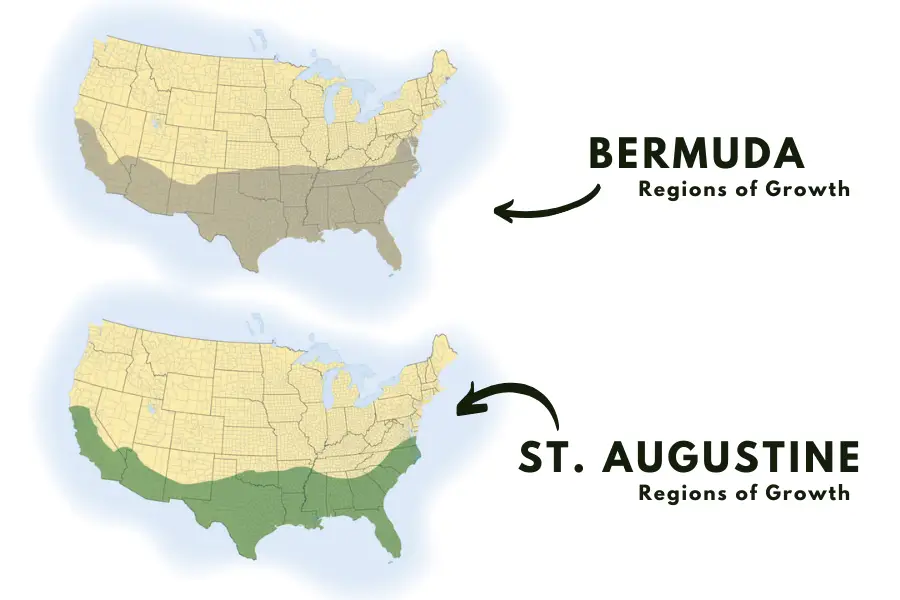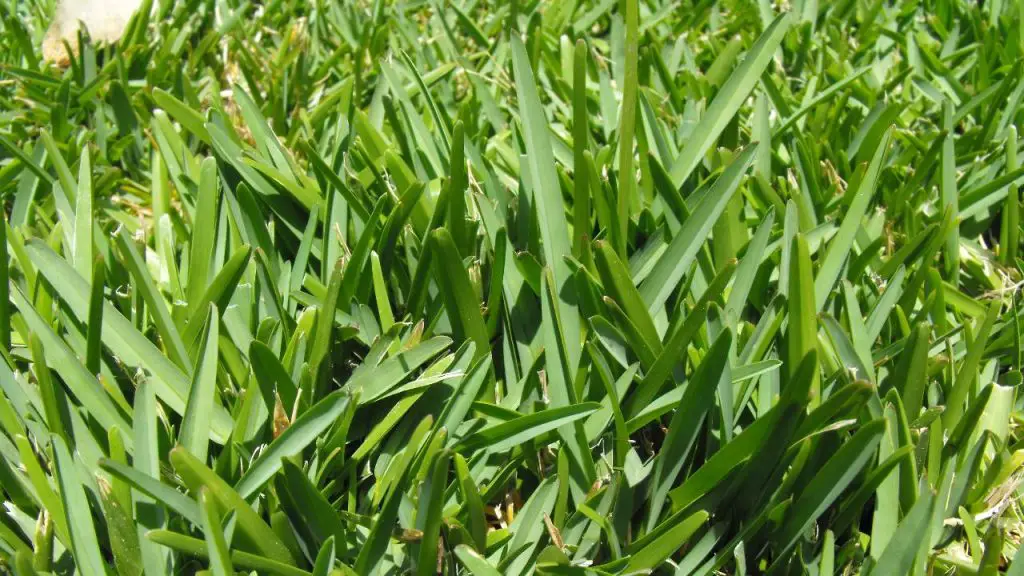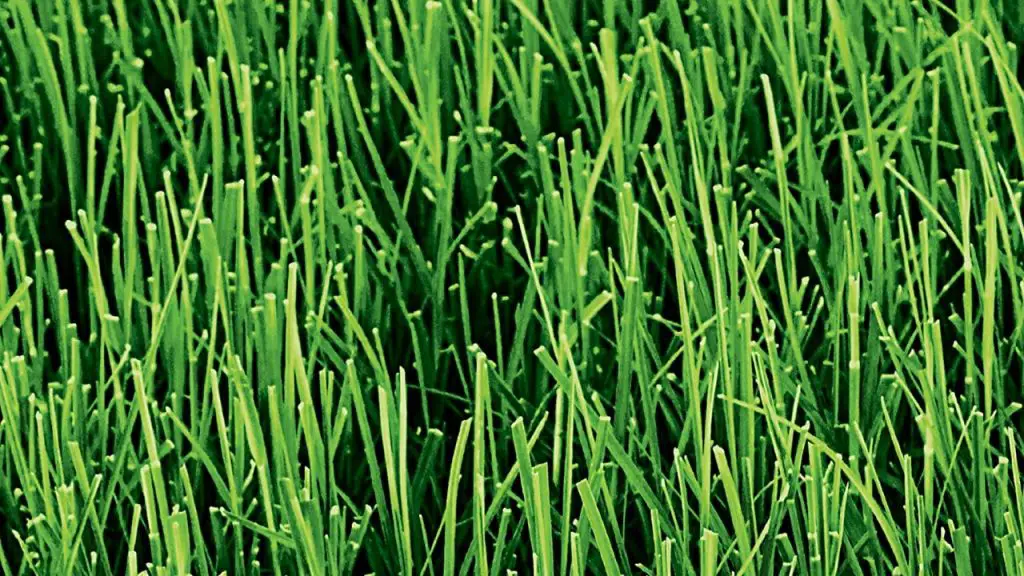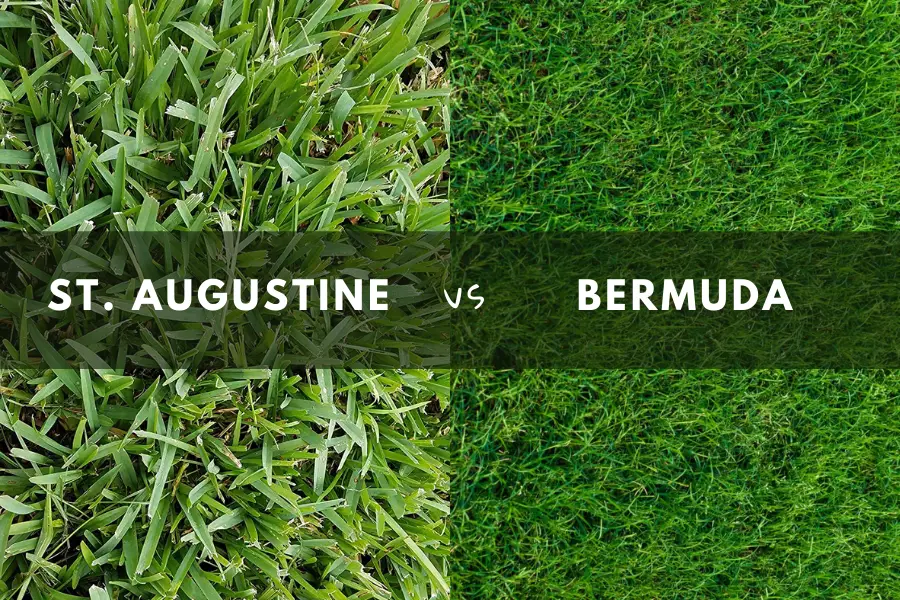Over a dozen grass varieties are suitable for lawns, but not all are ideal for your specific environment. Everyone dreams of a lush, healthy front lawn, and many know the pain of trial and error in warmer climates. It is, therefore, worth investigating which grass is the best choice for your yard. And in this article, we’ll cover which one to choose and the differences between St. Augustine Grass vs Bermuda Grass.
Bermuda grass is extremely drought-resistant and can survive hot weather in summer without water, while St. Augustine grass will require a lot of water to grow and stay healthy. St. Augustine grass works great to grow in the shade, while Bermuda is very dependant on getting full sun hours to grow strong and lush.
St. Augustine vs Bermuda | Lawn Grass for Warmer Climates
In areas such as Texas, California, and Florida, a warmer climate means not all kinds of lawn grass will thrive. Two of the most popular lawn grass varieties for warmer climates are St. Augustine and Bermuda – both do well in the Southern states, but which is the right choice for you? And how do you successfully maintain your beautiful new lawn?

This will come to depend mainly on critical environmental factors, as well as your ability to care for your lawn and the purpose it serves. In the image above, we can see how both varieties of grass grow best in the south. Both St. Augustine and Bermuda grass types are relatively low maintenance and thrive in the heat. They are popular for their hardiness against weeds. However, there is a lot they do not have in common. St. Augustine and Bermuda can serve different purposes, have different care requirements, and thrive best in different environments. Even in their appearance, these grasses can give a totally different impression.
Identifying Lawn Grass | Pictures

St. Augustine grass is characteristically coarse with a light to medium green color. The leaves are broad with a rounded tip and, when properly cared for, grow tightly together to create a dense carpet. St. Augustine grows quickly using above-the-ground runners, also known as stolons. It can be established using sod or plugs, not seed. There are several newly-developed varieties of St. Augustine that can vary slightly in appearance, but they all share the same basic characteristics. Remember that in order for St. Augustine to look its brightest and healthiest it should be planted in a tropical climate. It is known to flourish and grow its very best in Florida and other states along the Gulf.

Bermuda grass tends to be a darker grey-green with a finer leaf texture. It can be recognized by a few characteristic spikes at the end of the blade. It grows low to the ground using a deep roots system and can spread the same way as St. Augustine – using stolons – or by seeding. When starting a lawn of Bermuda grass, seeding is the most cost-efficient method. A lawn of Bermuda grass can be beautifully thick and responds well to regular maintenance in a tropical or subtropical climate, such as the Southwest, including Texas, California, and everywhere in between.
Although both varieties are popular and high quality, it is vital to note that the two warm-climate types of grass have some important distinctions. Let us outline the key differences between St. Augustine and Bermuda in order to find out which variety suits you and your needs best.

Need to Know Differences | St. Augustine vs Bermuda
| St. Augustine | Bermuda | |
| Watering | Thrives in hot, tropical wetness. Requires at least a one-inch soaking every 4-6 days during the dry season to encourage deep roots. | Highly drought resistant. Requires about half the amount of water as St. Augustine, and none in the winter when the grass is dormant. |
| Temperature | Thrives in temperatures between 55 and 105 degrees Fahrenheit. | Thrives in temperatures between 55 and 110 degrees Fahrenheit. |
| Sun Exposure | Requires about 5 hours of sunlight per day. Will tolerate shade. | Requires full sun. Does not adapt well to shady conditions. |
| Durability | Does not tolerate a high amount of foot traffic or other stressors. | Withstands wear better than most varieties. Tolerates heavy foot traffic and recovers quickly. |
| Fertilization | Requires fertilization two times per year with phosphate, nitrogen, and potassium – and throughout the dry season with a nitrogen fertilizer every two months. | Requires fertilization only two times per year with phosphate, nitrogen, and potassium. |
| Seed, Sod, & Soil | Prefers neutral alkaline soil. Best established using sod. | Prefers acidic soil. Best established using seed. |
| Price | Higher cost due to sod or plugs, as well as frequent fertilization and watering. | Seeding is less expensive than sod. Maintenance is fairly inexpensive and mainly attributed to frequent mowing. |
Sources: Lawn Care Academy, The Lawn Institute
As illustrated by the chart above, there are many differences between St. Augusta and Bermuda grass. Some of the most important takeaways are the factors out of your control – for example, sun exposure. Bermuda lawn grass will not thrive if your yard has shady patches or covered areas, while St. Augustine will do well in sun and heat as well as shade. St. Augustine grass will, however, need more frequent watering.
Remember that both types of grass come in several varieties, which may hold slightly differing characteristics. All of this is to be taken into consideration when deciding on the perfect grass for your lawn, but it is almost certain that the most deciding factor is the natural environment – sun, shade, and water.
What Else to Consider Before Choosing Between St. Augustine and Bermuda
Care
It is also important to be prepared to care properly for your lawn. Both varieties require fertilization, regular watering, and regular mowing. Proper maintenance of your lawn will help ensure healthy growth.
When growing St. Augustine grass, is it important to remember to
- Water deeply instead of frequently
- Allow for about two to three inches of growth when mowing
- De-thatch or aerate when necessary
- Fertilize often with nitrogen fertilizer
When growing Bermuda grass, is it important to remember to
- Water less frequently, avoid ‘drowning’ the grass
- Allow for about one to two inches when mowing (slow growth means less mowing)
- Fertilize just twice a year with a regular fertilizer
Weeds & Pests
Both St. Augustine and Bermuda owe much of their popularity to their natural hardiness and aggression towards weeds. Dandelions, fungus diseases, and other pesky, unwanted guests are not a large threat to a healthy, well-maintained lawn of either variety, as long as your lawn is properly taken care of. Proper mowing and aeration can make the difference.
If your St. Augustine lawn is facing an infestation, the most common culprit is the chinch bug. They can be identified in a lawn that appears to be suffering from drought and has large, dry brown patches. This is because the bug injects a poison into the blades of grass it feeds from. An easy solution is to treat your lawn with a basic insecticide.
If weeds from neighboring lawns are the issue, treat your St. Augustine grass once and the spring and again in the fall with a herbicide.
Remember to de-thatch your lawn before applying insecticides or herbicides, to ensure the product reaches the soil.
Many kinds of pests and insects can be found in Bermuda grass, but Japanese beetles and their grubs do the most damage. These pests can become a big problem requiring a lot of time and effort to get rid of. However, if you manage to nip it in the bud with a preemptive insecticide, there will be no need to take extra measures.
Weeds such as clover, bluegrass, and crabgrass are known to grow in Bermuda grass. Just as St. Augustine, the most strategic way to combat unwanted grasses is to treat your lawn before it becomes an issue – first with a pre-emergent herbicide in the spring, then again in the fall.
Most importantly, proper lawn care and maintenance is the number one method for prevention of pests and weeds in both St. Augustine and Bermuda grass.
The Best Lawn Grass for You
Before beginning to weigh your options and make the decision between St. Augustine vs Bermuda, there are external factors to be aware of that might just make the decision for you, such as geographic location, environment, or landscaping.
Do you live in a high-risk drought area, such as Southern California? Then Bermuda grass, which requires much less watering than other varieties and is known as drought-resistant, is likely the better choice. Does your yard have a lot of foliage and trees casting shade on your lawn? In this case, St. Augustine would be the grass better suited for your lawn.
Factors created by your own personal habits and needs can also come into play. Consider if there will be children making use of the lawn or if the grass is purely decorative. For a functional, durable lawn that can handle foot traffic and pets, Bermuda will serve well. This variety should also be considered if you plan on furnishing your lawn or storing anything on it. If looking to lay down sod and achieve the brighter color of St. Augustine grass, make sure you are prepared for a physical and financial commitment to a higher maintenance lawn with regular mowing, fertilizing, and water.
Using the chart above, and maybe the help of an expert, you now have the resources necessary to make an informed decision about which warm climate grass to use for your lawn. The decision is up to you but remember to take environment, upkeep, and the lawn’s sole purpose into account before deciding between St. Augustine and Bermuda grass.
